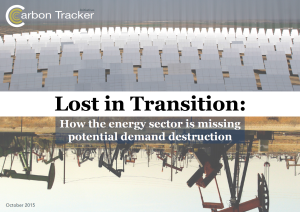Lost in Transition:
How the energy sector is missing potential demand destruction
 Carbon Tracker’s latest study published today finds that fossil fuel companies cherry pick forecasts on world population growth, global economic growth and energy intensity, without considering alternative forecasts that would lead to much lower demand. For example, many use the IEA forecast of 3.4% global growth to 2040, but OECD forecasts of 3.1% would cut demand dramatically.
Carbon Tracker’s latest study published today finds that fossil fuel companies cherry pick forecasts on world population growth, global economic growth and energy intensity, without considering alternative forecasts that would lead to much lower demand. For example, many use the IEA forecast of 3.4% global growth to 2040, but OECD forecasts of 3.1% would cut demand dramatically.
The new report for the first time compares published industry scenarios against authoritative financial market research. The report finds that energy companies are overlooking the scale and pace at which demand for oil, coal and gas could fall as rapid advances in renewables and battery technologies together with international climate change commitments put the world on a low-carbon trajectory.
Please find here the press release, executive summary and the full report.
The report finds that most published scenarios show fossil fuel demand growing 30%-50% and still providing three quarters of energy demand by 2040. They are inconsistent with last week’s pledge by 10 major oil and gas companies to take action to limit global warming to 2C.
Key facts that fossil fuel company scenarios do not take account include:
- 150 countries have made decarbonisation pledges that point to significantly lower demand than in energy industry scenarios, which are consistent with 4-6 degrees of warming.
- The cost of energy storage is falling rapidly and will accelerate deployment of renewables by removing the problem of intermittent generation. Deutsche Bank expects renewables and energy storage to match grid supply costs in Germany in 2016. Financial house Bernstein sees solar PV plus storage outcompeting retail power prices by 2018 in Australia, Japan, Spain and Brazil. Google and Apple are investing a combined $4.8bn in these markets.
- Renewables plus storage will compete with gas to provide baseload capacity once costs reach parity, making new gas plants less viable.
- Energy efficiency and electric vehicles will hit demand for oil in its biggest sector, road transport. China, which accounted for 58% of all non-OECD car sales in 2013, has introduced strict efficiency targets as has India. Electric vehicles could be cost-competitive with internal combustion engine cars by 2025, according to Bernstein.
- Global coal demand is in structural decline. Demand in China fell by 2.9% in 2014 and 5% in the first half of 2015. India announced renewable energy targets for 2022 that, with increasing domestic coal production, could displace all foreign coal imports.
